New Delhi, Jun 22: India's COVID-19 cases per lakh people is one of the lowest in the world despite its high population density, and the recovery rate has now reached almost 56 per cent, the Union Health Ministry said on Monday.
For every one lakh population, there are 30.04 coronavirus cases in India, while the global average is over three times at 114.67, the ministry said, referring to the WHO Situation Report 153, dated June 21.
This low figure is thus a testimony to the graded, pre-emptive and pro-active approach the Government of India along with the states and UTs took for prevention, containment and management of COVID-19," the ministry said in a statement.
Citing the WHO Situation Report, the ministry said the US has 671.24 cases per lakh population, while Germany, Spain, Brazil and the UK have 583.88, 526.22, 489.42 and 448.86 cases per lakh population, respectively.
It said Russia has 400.82 cases per lakh people, while Italy, Canada, Iran and Turkey have 393.52, 268.98, 242.82 and 223.53, respectively.
Coming back to India, as on Monday morning, the total number of coronavirus cases stood at 4,25,282 and the death toll at 13,699, according to figures issued by the ministry.
In its update issued at 8 AM Monday, the ministry said 9,440 COVID-19 patients recovered in the last 24 hours, taking the total number of recoveries to 2,37,195, a recovery rate of 55.77 per cent.
Presently, there are 1,74,387 active cases and all are under medical supervision, it said.
"The difference between the recovered patients and the active COVID-19 cases continues to widen. Today, the number of recovered patients has crossed the number of active patients by 62,808," the ministry said.
The COVID-19 testing infrastructure is continuously being ramped up and number of government labs has been increased to 723 and the private labs to 262, adding up to a total of 985, it said.
According to the Indian Council of Medical Research, a total of 69,50,493 samples have been tested up to 21 June, 1,43,267 of them just on Sunday.
On Monday, the country added 14,821 new COVID-19 cases in a single day, pushing the tally to 4,25,282, while the death toll rose to 13,699 with 445 new fatalities reported till 8 am.
The country breached the four lakh-mark on Sunday, eight days after crossing three lakh COVID-19 cases. It has recorded 2,34,747 infections since June 1.
Monday was the 11th day in a row when the country registered over 10,000 cases.






Comments
Add new comment